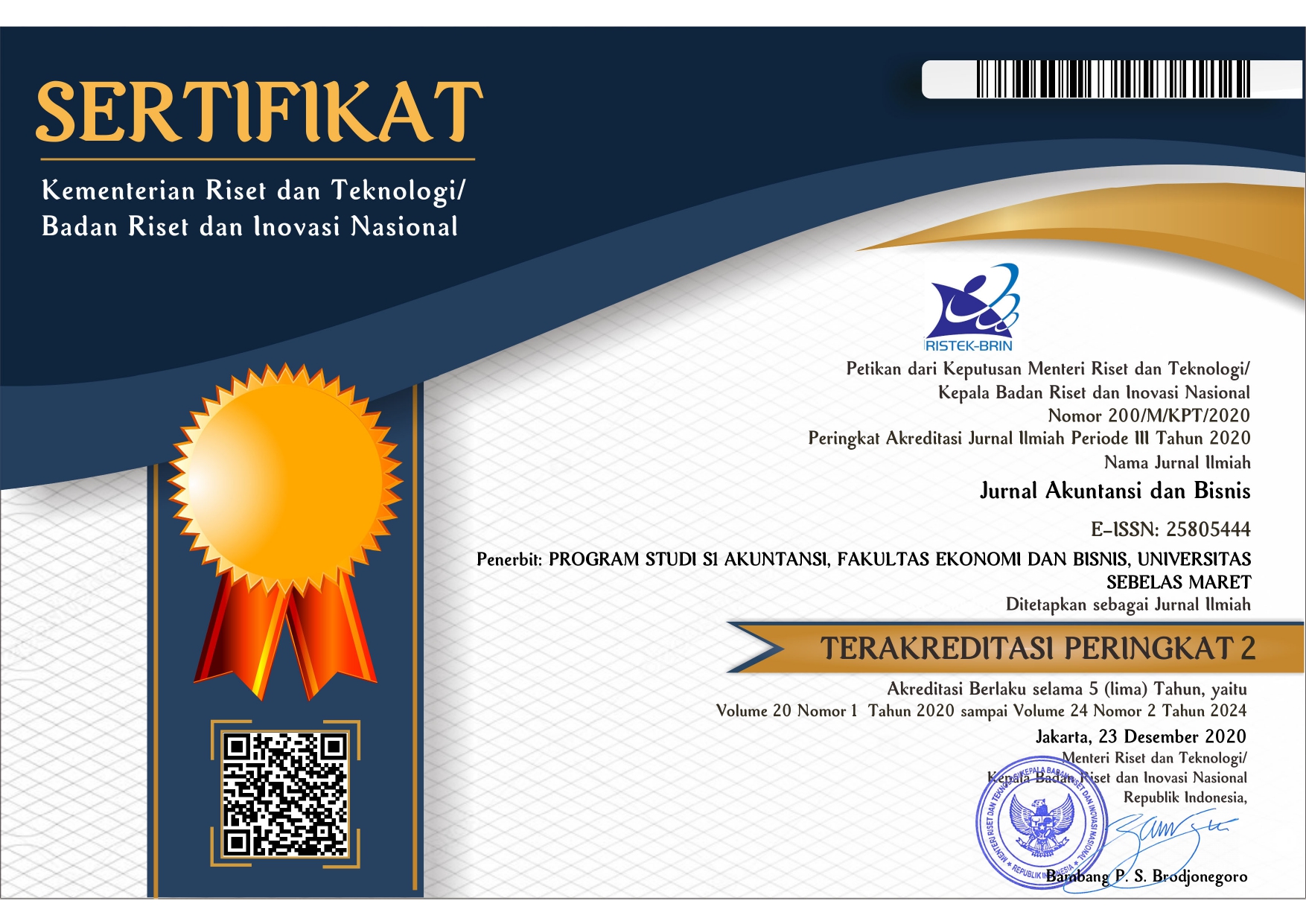Modal Organisasi, Nilai Perusahaan dan Penghindaran Pajak
Abstract
Keywords
Full Text:
PDFReferences
Badan Pusat Statistik Indonesia. (2022.). Realisasi Pendapatan Negara (Milyar Rupiah). Retrieved October 19, 2022, Diakses dari https://www.bps.go.id/indicator/13/1070/2/realisasi-pendapatan-negara.html
Barid, F. M., & Wulandari, S. (2021). Praktik Penghindaran Pajak Sebelum dan Setelah Pandemi Covid – 19 di Indonesia. Jurnal Riset Akuntansi & Perpajakan (JRAP), 8(02), 68–74.
Blundell, R., & Matyas, L. (1992). Panel Data Analysis : An Introductory Overview. Structural Change and Economic Dynamics Journal, 3(2), 1–492.
Borenstein, M., Hedges, L. v., Higgins, J. P. T., & Rothstein, H. R. (2010). A basic introduction to fixed-effect and random-effects models for meta-analysis. Research Synthesis Methods, 1(2), 97–111.
Chen, X., Hu, N., Wang, X., & Tang, X. (2014). Tax avoidance and firm value: evidence from China. Nankai Business Review International, 5(1), 25–42.
Cheng, A. C. S., Huang, H. H., Li, Y., & Stanfield, J. (2012). The effect of hedge fund activism on corporate tax avoidance. Accounting Review, 87(5), 1493–1526.
Chyz, J. A., Ching Leung, W. S., Zhen Li, O., & Meng Rui, O. (2013). Labor unions and tax aggressiveness. Journal of Financial Economics, 108(3), 675–698.
Desai, M. A., & Dharmapala, D. (2005). Corporate Tax Avoidance & Firm Value. NBER Working Paper, 11241,1-25
Desai, M. A., and Dharmapala, D. (2009). Corporate tax avoidance and firm value. The Review of Economics and Statistics, 91(3), 537-546.
Eisfeldt, A. L., & Papanikolaou, D. (2013). Organization capital and the cross-section of expected returns. Journal of Finance, 68(4), 1365–1406.
Gómez, J. G. A. (2020). Lagrange Multiplier Tests in Applied Research. Journal de Ciencia e Ingeniería, 12(1), 13–19.
Hanlon, M., & Slemrod, J. (2009). What does tax aggressiveness signal? Evidence from stock price reactions to news about tax shelter involvement. Journal of Public Economics, 93(1–2), 126–141.
Hasan, M. M., Lobo, G. J., & Qiu, B. (2021). Organizational capital, corporate tax avoidance, and firm value. Journal of Corporate Finance, 70, 1-27.
Hasbi, H. (2015). Islamic Microfinance Institution: The Capital Structure, Growth, Performance and Value of Firm in Indonesia. Procedia - Social and Behavioral Sciences, 211, 1073–1080.
Holiawati, & Murwaningsari, E. (2019). Intellectual Capital, Tax Avoidance and Firm Value. International Journal of Business, Economics and Law, 18(5), 219–227.
Iqbal, U., Nadeem, M., Gull, A. A., & Kayani, U. N. (2022). Environmental innovation and firm value: The moderating role of organizational capital. Journal of Environmental Management, 316.
Irawan, F., & Turwanto. (2020). The Effect of Tax Avoidance on Firm Value with Tax Risk as Moderating Variable. Journal of Engineering and Management, 9696–9707.
Kim, T. K. (2005). T Test as A Parametric Statistic. Korean Journal of Anesthesiology, 540–546.
Lee, H. B. (2008). Using the Chow Test to Analyze Regression Discontinuities. Tutorials in Quantitative Methods for Psychology Journal, 4(2), 46–50.
Marr, B., & Roos, G. (2005). A Strategy Perspective on Intellectual Capital. In Perspectives on Intellectual Capital (pp. 28–41). Elsevier.
Martani, D., Fitriasari, D., Yulianti. (2010). Influence of book tax gap towards earnings persistence and firm value for the period of 1999–2007. The 3rd Accounting & The 2nd Doctoral Colloquium Bridging the Gap between Theory, Research and Practice: IFRS Convergence and Application.
Martín-de-Castro, G., Navas-López, J. E., López-Sáez, P., & Alama-Salazar, E. (2006). Organizational capital as competitive advantage of the firm. In Journal of Intellectual Capital, 7(3), pp. 324–337.
Mhedhbi, I. (2013). The Company’s Intellectual Capital:Interaction and Value Creation Case of Tunisian Companies. Journal of Asian Business Strategy, 3(1), 1–10.
Mutl, J., & Pfaffermayr, M. (2011). The Hausman Test in A Cliff and Ord Panel Model. Econometrics Journal, 14(1), 48–76.
Neuman, S. S. (2014). Effective Tax Strategies It’s Not Just Minimization. SSRN Electronic Journal, 1-53.
Panda, B., & Leepsa, N. M. (2017). Agency theory: Review of theory and evidence on problems and perspectives. Indian Journal of Corporate Governance, 10(1), 74–95.
Poretti, C., & Heo, C. Y. (2022). COVID-19 and firm value drivers in the tourism industry. Annals of Tourism Research, 95.
Putra, P. D., Syah, D. H., & Sriwedari, T. (2018). Tax Avoidance: Evidence of As a Proof of Agency Theory and Tax Planning. International Journal of Research & Review, 5(9), 52–60.
Sekaran, U., & Bougie, R. (2016). Research Method of Business (6th edition). John Wiley & Son Inc.
SIS International. (2022.). What is Quantitative Research? Retrieved October 12, 2022, diakses dari
https://www.sisinternational.com/what-is-quantitative-research/
Tseng, C.-Y., & Goo, Y.-J. J. (2005). Intellectual capital and corporate value in an emerging economy: empirical study of Taiwanese manufacturers, 35 (2) 187-201.
Ulfa, Z., & Prasetyo, K. (2018). The Effect of Intellectual Capital and Revenue Growth on Firm Value. Journal of Contemporary Accounting and Economics, 422–427.
Wang, J.-C. (2021). Tax Avoidance and Firm Value: A Two-Stage Regression Analysis. Journal of Business Management, 2(4), 88–97.
Wulandari, M.A., & Soetardjo, M.N. (2022). Pengaruh Penghindaran Pajak terhadap Nilai Perusahaan. Jurnal Penelitian Akutansi, 3(2), 216-230.
Yee, C. S., Sapiei, N. S., & Abdullah, M. (2018). Tax Avoidance, Corporate Governance and Firm Value in The Digital Era. Journal of Accounting and Investment, 19(2).
DOI: http://dx.doi.org/10.20961/jab.v23i2.1121
Jurnal Akuntansi dan Bisnis (JAB)
ISSN 1412-0852 (print), 2580-5444 (online)
Published by Accounting Study Program, Faculty of Economics and Business, Universitas Sebelas Maret, Indonesia

JAB on http://jab.fe.uns.ac.id/index.php/jab is licensed under a Creative Commons Attribution-ShareAlike 4.0 International License










